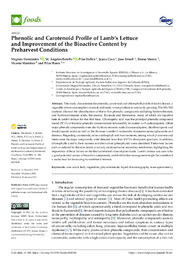Please use this identifier to cite or link to this item:
https://hdl.handle.net/11000/32437Full metadata record
| DC Field | Value | Language |
|---|---|---|
| dc.contributor.author | Hernández, Virginia | - |
| dc.contributor.author | Botella, M. Ángeles | - |
| dc.contributor.author | Hellín, Pilar | - |
| dc.contributor.author | Cava, Juana | - |
| dc.contributor.author | Fenoll, Jose | - |
| dc.contributor.author | Mestre, Teresa | - |
| dc.contributor.author | Martínez, Vicente | - |
| dc.contributor.author | Flores, Pilar | - |
| dc.contributor.other | Departamentos de la UMH::Biología Aplicada | es_ES |
| dc.date.accessioned | 2024-07-12T08:14:35Z | - |
| dc.date.available | 2024-07-12T08:14:35Z | - |
| dc.date.created | 2021-01 | - |
| dc.identifier.citation | Foods 2021, 10(1), 188 | es_ES |
| dc.identifier.issn | 2304-8158 | - |
| dc.identifier.uri | https://hdl.handle.net/11000/32437 | - |
| dc.description.abstract | This study characterizes the phenolic, carotenoid and chlorophyll profile of lamb’s lettuce, a vegetable whose consumption in salads and ready-to-eat products is constantly growing. The MS/MS analysis allowed the identification of thirty-five phenolic compounds including hydroxybenzoic and hydroxycinnamic acids, flavanones, flavanols and flavanones, many of which are reported here in lamb’s lettuce for the first time. Chlorogenic acid was the principal phenolic compound found (57.1% of the total phenolic concentration) followed by its isomer cis-5-caffeoylquinic. Other major phenolic compounds were also hydroxycinnamic acids (coumaroylquinic, dicaffeoylquinic and feruloylquinic acids) as well as the flavones luteolin-7-rutinoside, diosmetin-apiosylglucoside and diosmin. Regarding carotenoids, seven xanthophyll and four carotenes, among which b-carotene and lutein were the major compounds, were detected from their UV-Vis absorption spectrum. In addition, chlorophylls a and b, their isomers and derivatives (pheophytin) were identified. Preharvest factors such as reduced fertilization levels or salinity increased some secondary metabolites, highlighting the importance of these factors on the final nutritional value of plant foods. Lamb’s lettuce was seen to be a good potential source of bioactive compounds, and fertilization management might be considered a useful tool for increasing its nutritional interest. | es_ES |
| dc.format | application/pdf | es_ES |
| dc.format.extent | 14 | es_ES |
| dc.language.iso | eng | es_ES |
| dc.publisher | MDPI | es_ES |
| dc.rights | info:eu-repo/semantics/openAccess | es_ES |
| dc.rights | Attribution-NonCommercial-NoDerivatives 4.0 Internacional | * |
| dc.rights.uri | http://creativecommons.org/licenses/by-nc-nd/4.0/ | * |
| dc.subject | corn salad | es_ES |
| dc.subject | leafy vegetables | es_ES |
| dc.subject | phytochemicals | es_ES |
| dc.subject | liquid chromatography | es_ES |
| dc.subject | mass spectrometry | es_ES |
| dc.subject.other | CDU::5 - Ciencias puras y naturales::57 - Biología | es_ES |
| dc.title | Phenolic and Carotenoid Profile of Lamb’s Lettuce and Improvement of the Bioactive Content by Preharvest Conditions | es_ES |
| dc.type | info:eu-repo/semantics/article | es_ES |
| dc.relation.publisherversion | https://doi.org/10.3390/foods10010188 | es_ES |

View/Open:
foods-10-00188-v2.pdf
333,74 kB
Adobe PDF
Share:
.png)
